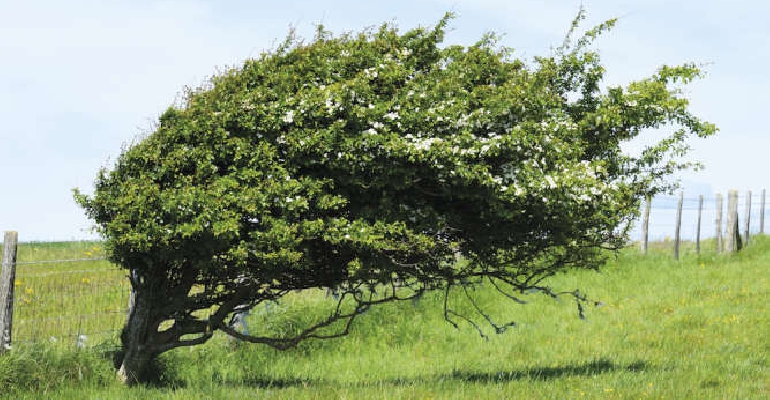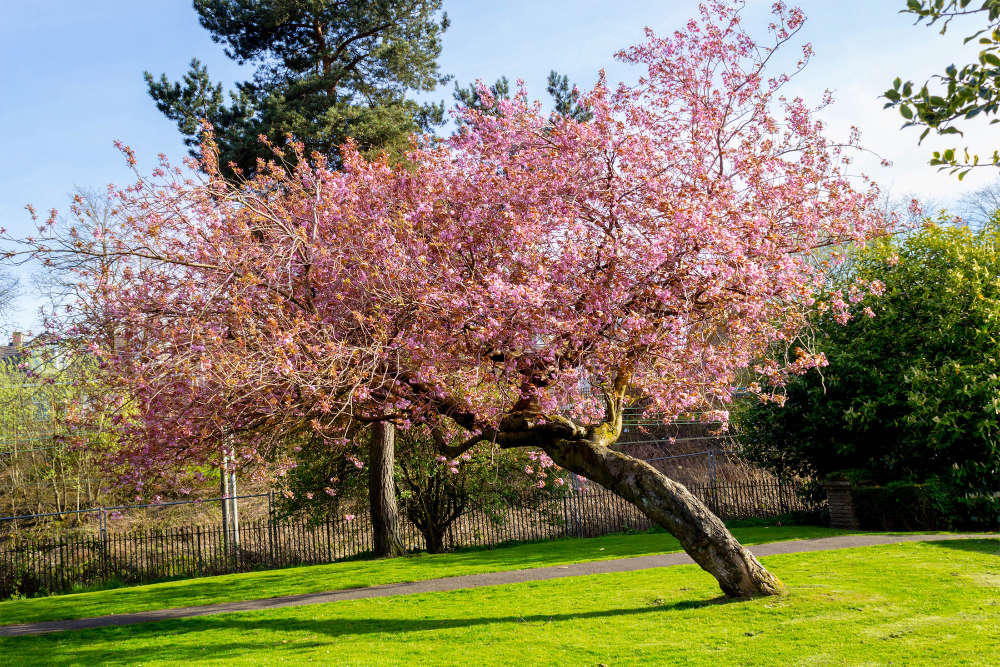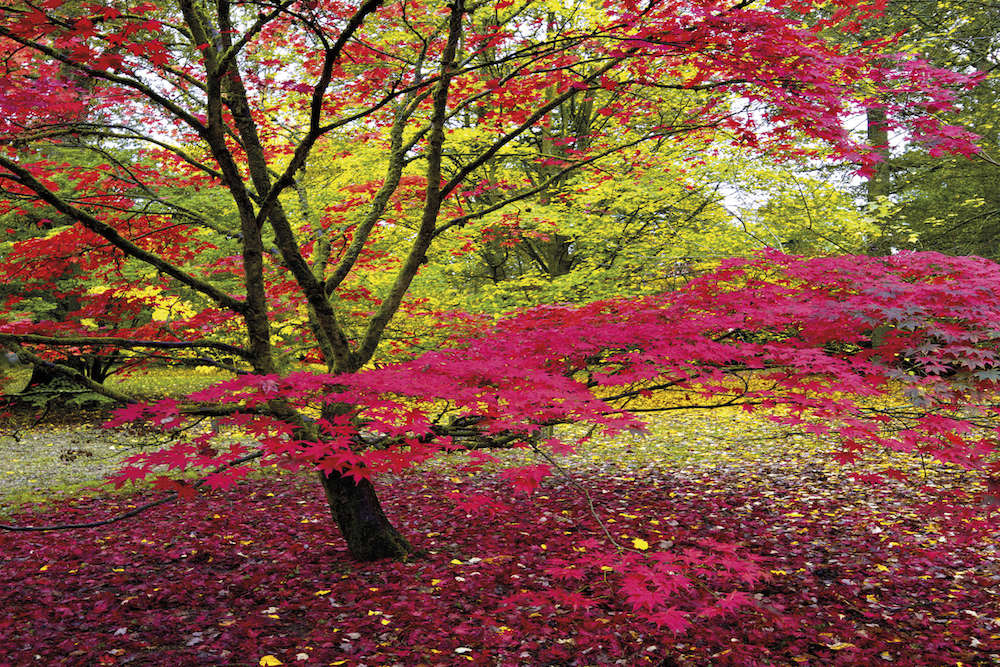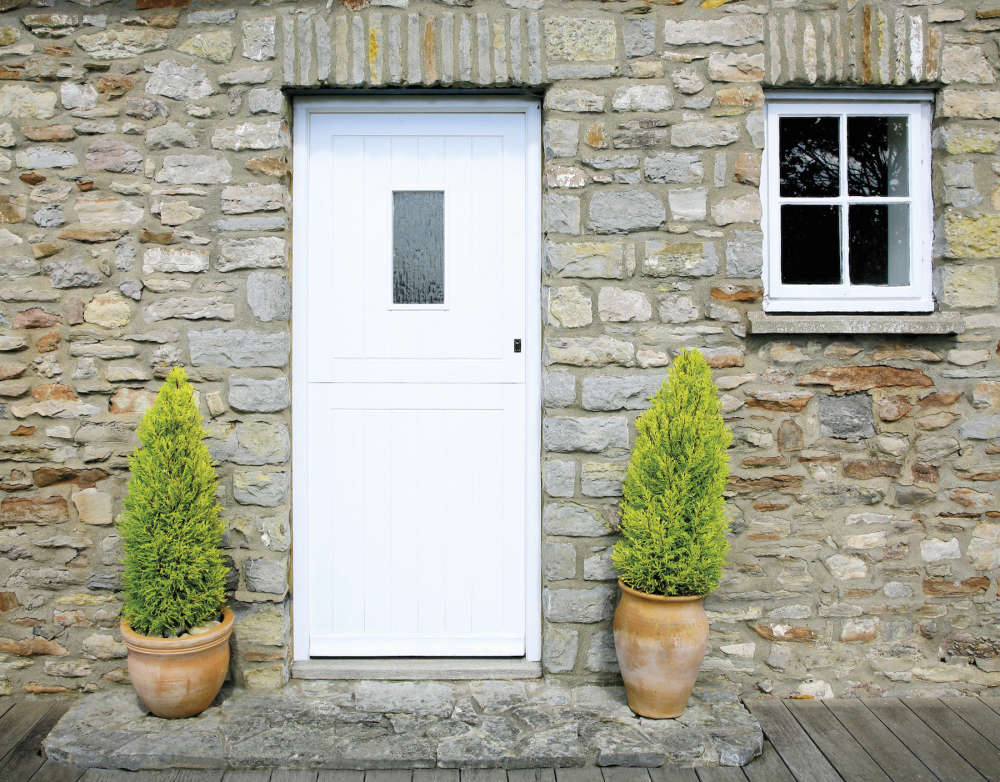
Small garden? Reckon you don’t have room for a tree? Think again, says Flo Whitaker. There are trees to suit every location – and now’s the best time to plant one
If there’s a prize for the most unfussy tree, hawthorn is surely a contender. You’ll find the native form (Crataegus monogyna) dotted across the Sussex Downs. Windblown into mad, sculptural shapes; they anchor themselves into thin soil and endure the extremes of downland weather, so will easily cope with whatever conditions your garden has to offer – only deep shade and waterlogged ground deters them. Hawthorn is a terrific food plant for wildlife; producing clusters of nectar-rich white flowers in spring and blood red berries in autumn. Some cultivar forms have pink flowers, while others offer spectacular autumn leaf colour.
Nothing says ‘spring’ more than an ornamental cherry, (Prunus) bedecked in blossom, but choose with care – some can grow as wide as they are high, although may take a considerable time to do so. Many cultivars also produce autumn fruits which, although highly decorative, are usually bitter and inedible, (unless you’re a blackbird). In a small garden, plants that offer more than one season of interest are particularly useful, so decorative bark/stems are other factors to consider – especially at this time of year. The Tibetan Cherry, (Prunus serrula) produces amazing mahogany-coloured glossy bark. The birch family, (Betula) are also noted for fabulous bark; the variety ‘Jacquemontii’ has the whitest, ghostliest bark imaginable.

Cultivars with a pendulous or ‘weeping’ habit are often less vigorous than their upright counterparts – useful to remember if space is very restricted. Tall-growing shrubs with multi-stemmed habits can be employed to give the aesthetic appearance of a tree – they helpfully straddle the tree/shrub divide. Members of the viburnum family have much to offer in this regard, as do cotinus and cornus.
Trees in pots are useful in a small, patio-style space; giving height and interest to an area which may offer nothing other than a uniformly flat surface. No two trees ever grow in the same way and they have the extraordinary ability to quickly take on characterful aspects. Acers are especially good at this trick; appearing venerable and stately from an early age. The general rule for acers is that they require shelter and shade but, while the former is correct, some acers are happy in bright light. As a guide; the darker their foliage, the more sunshine tolerant, (the reddish leaf pigment is nature’s sunscreen). If you like acers but cannot provide sheltered conditions, members of the sambucus family, with their acer-like foliage and robust constitutions may fit the bill. Try Sambucus ‘Black Lace’ for ultra-dark leaves, or ‘Sutherland Gold’ for zingy, bright foliage. Sambucus enjoys a sunny spot and, unlike acers, laughs in the face of an easterly gale.

Potted evergreens are stalwarts of the winter garden. Instead of vigorous, pot-busting taproots, conifers tend to make clumps of fine roots, making them ideal for containers, so long as the compost remains moist. When planting any tree in a pot, avoid multi-purpose compost. What they really enjoy is a soil-based medium that has slow-release fertiliser and water-retaining material added. Soil-based composts are much heavier than multi-purpose types as they also contain grit/sand to mimic natural soil conditions. This also has a practical advantage as heavy pots are less likely to topple over in windy weather.
Some folk reckon conifers are boring because, ‘they don’t do anything.’ Nonsense! How can you accuse a plant of laziness when it looks good for 365 days of the year with virtually zero effort from you? They do have seasons of interest – they’re just more subtle about it. Old leaves, (‘needles’) are quietly shed during growth spurts – typically in spring and autumn. Their juvenile foliage is brighter in colour; giving pink-ish, golden or silvery highlights and, of course, there are wintery cones and dramatic, frost rimmed outlines to look forward to. For most of the year, conifers modestly stay in the background, but, come winter, they step forward into the spotlight, resplendent in their smart evergreen costumes. No matter how small, every garden has space for a tree – and the garden centres are currently full of them. What are you waiting for!


 Blooming Times: Happy Faces
Blooming Times: Happy Faces
 Blooming Times: Winter Sparklers
Blooming Times: Winter Sparklers
 Homes Extra: Restore, Repair, Recycle
Homes Extra: Restore, Repair, Recycle
 Home Style: A Scandi Winter's Tale
Home Style: A Scandi Winter's Tale
 Blooming Times: Winter Wonders
Blooming Times: Winter Wonders
 Home Style: Bold, Brave & Beautiful
Home Style: Bold, Brave & Beautiful
 Blooming Times: The Answer Lies in the Soil
Blooming Times: The Answer Lies in the Soil
 Blooming Times: Heavenly Hyacinths
Blooming Times: Heavenly Hyacinths
 Legendary Builds with Phoenix Construction Services
Legendary Builds with Phoenix Construction Services
 Blooming Times: Know Your Enemy
Blooming Times: Know Your Enemy
 Bespoke Dreams from Eridge Green Kitchens
Bespoke Dreams from Eridge Green Kitchens
 10 Hot Years: iFit Fires & Flues
10 Hot Years: iFit Fires & Flues
 Home Style: Bold Type
Home Style: Bold Type
 Blooming Times: The Sky's the Limit
Blooming Times: The Sky's the Limit
 Home Style: A Better Way of Life
Home Style: A Better Way of Life
 Homes Extra: Shed Space
Homes Extra: Shed Space
 Blooming Times: Top of the Pots
Blooming Times: Top of the Pots
 Kids Zone: Get the Kids Growing
Kids Zone: Get the Kids Growing
 Home Style: Pastures New
Home Style: Pastures New
 Homes Extra: Let There Be Light
Homes Extra: Let There Be Light